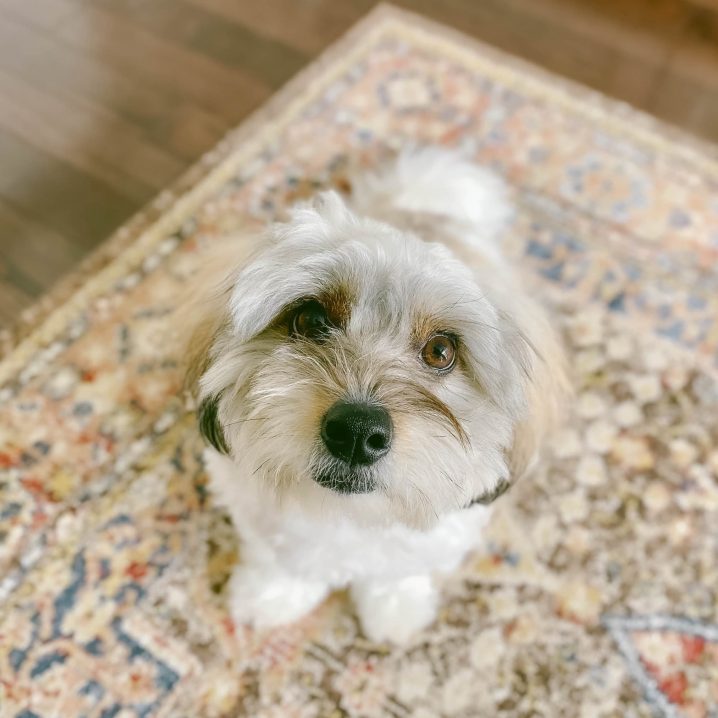
- POPSUGAR Australia
- Living
- Our Puppy's Separation Anxiety Is Awful, So I Asked 2 Experts How to Calm Him Down
Our Puppy's Separation Anxiety Is Awful, So I Asked 2 Experts How to Calm Him Down

Separation anxiety in dogs and puppies can be incredibly trying for an owner. The whining that ensues upon your departure invokes all the guilt in the world. For my family, we got our puppy as soon as the world stopped due to the COVID-19 pandemic. It wasn’t planned that way; it just sort of happened. So, because we were home all the time, his separation anxiety only got worse. Luckily, I have a great veterinarian and dog trainer who help me ease my puppy’s nerves when we leave. Here’s what they suggest if you’re struggling, too.
Related: 12 Things You Need to Buy When You Bring Home a New Puppy
What Does Separation Anxiety Look Like in Dogs?
Separation anxiety can create extra stress for both of you, owner and dog. Sometimes, puppies will follow you everywhere and whine the second you’re out of sight. Other times, they can bark the second you put them in their crate, for hours on end. When separation anxiety gets really bad, they may have accidents in the house or even become destructive (think chewing through furniture, ripping up carpets, etc.). So it’s vital that you nip separation anxiety in the bud as soon as possible.
What Should a Dog Owner Do Before Leaving the House to Prevent Separation Anxiety?
Maria LaCombe from Einstein Dog Training in Michigan said it’s important to tire out your dog before you leave. “A good dog is a tired dog – but they have to be both physically and mentally tired,” she explained. I had never thought about the mental part of it before. I simply thought that running your dog ragged was all I needed to do. LaCombe suggested using a flirt pole – which is essentially a big cat toy that entices your dog to move toward a fast-paced lure. These toys provide your puppy extra stimulation to help wear them out both physically and mentally. LaCombe also suggested freezing a Kong toy filled with food mixed with some yogurt or pumpkin. Because your dog will have to work to get the food out, they’re engaged on a mental and physical level. If you want to tire out your dog with a game of fetch or tug of war, you can also add some obedience training before leaving to mentally poop them out.
Should I Crate My Dog When I Leave the House?
LaCombe recommended using a crate when you leave. To properly use a crate, simply encourage them into it (you can use treats, but never scold) and calmly latch the door shut. The crate should be a safe place for your dog. Be sure to place some covering over the top to make it cozy, but LaCombe cautioned owners to be sure the covering isn’t too thick – it could accidentally suffocate a puppy. If you’re worried about this, ask your veterinarian for suggestions. If your puppy is having a really hard time when you leave, try to minimize visual stimulation by putting their crate in a calm corner of the house, away from a window or other people, so they can’t see what’s going on, LaCombe suggested. For puppies that need a little extra reassurance, she recommended you could put on a white-noise machine or a fan to help them self-soothe – much like you might do for a baby.
Related: I Worked as a Puppy Trainer, and These Are My Top Tips For Teaching Good Behavior
How Often Should I Leave My Puppy When Trying to Ease Their Separation Anxiety?
Dr. Joe Hendricks, a veterinarian at Briarwood Veterinary Hospital in Grand Blanc, MI, suggested you build up the amount of time you leave your puppy – start with a few minutes and work up from there. He likes to give his own puppy a Kong toy to play with in the crate so they have something else to concentrate on besides your departure. When you leave, crate your dog, and simply say, “I’ll be back,” before heading out. You shouldn’t make your departure a grand gesture, as it could stress out your dog more.
How Should I Handle Coming Back Home to My Dog?
When you come back, Dr. Hendricks recommended, immediately take your puppy outside to relieve themselves first. You shouldn’t immediately give lots of hugs and kisses out of guilt of being gone (though you can smother your fur baby with praise after they go potty). And be sure not to let your dog dart out of the crate; they should exit calmly. Slowly open the crate door, and shut it quickly if you think they are going to rush out. Repeat until they recognize they should exit at your command. This reminds your dog that you are in charge.
Will Creating a Schedule Help With Their Separation Anxiety?
Leaving your puppy is an important part of their development because it helps them become independent, but helping them understand you’ll be gone at regular intervals can help. “You must create a schedule for your dog so that they have times during the day to work, play, rest, and eat,” LaCombe said. Leaving your dog must be integrated into this schedule as well. This way they know you’ll come back and they can remain safe and content both with and without you.

